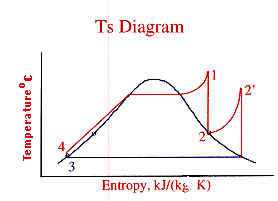

RANKINE CYCLE
Saturated or superheated steam enters the turbine at state 1, where it expands isentropically to the exit pressure at state 2. The steam is then condensed at constant pressure and temperature to a saturated liquid, state 3. The heat removed from the steam in the condenser is typically transferred to the cooling water. The saturated liquid then flows through the pump which increases the pressure to the boiler pressure (state 4), where the water is first heated to the saturation temperature, boiled and typically superheated to state 1. Then the whole cycle is repeated.
the water is first heated to the saturation temperature, boiled and typically superheated to state 1. Then the whole cycle is repeated.TYPICAL MODIFICATIONS

REHEAT
When steam leaves the turbine, it is typically wet. The presense of water causes erosion of the turbine blades. To prevent this, steam is extracted from high pressure turbine (state 2), and then it is reheated in the boiler (state 2') and sent back to the low pressure turbine.REGENERATION
Regeneration helps improve the Rankine cycle efficiency by preheating the feedwater into the boiler. Regeneration can be achieved by open feedwater heaters or closed feedwater heaters. In open feedwater heaters, a fraction of the steam exiting a high pressure turbine is mixed with the feedwater at the same pressure. In closed system, the steam bled from the turbine is not directly mixed with the feedwater, and therefore, the two streams can be at different pressures.Engineering Thermodynamics by Jones, J. B., Dugan, R. E.,




0 comments:
Post a Comment